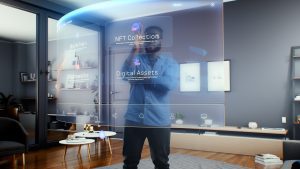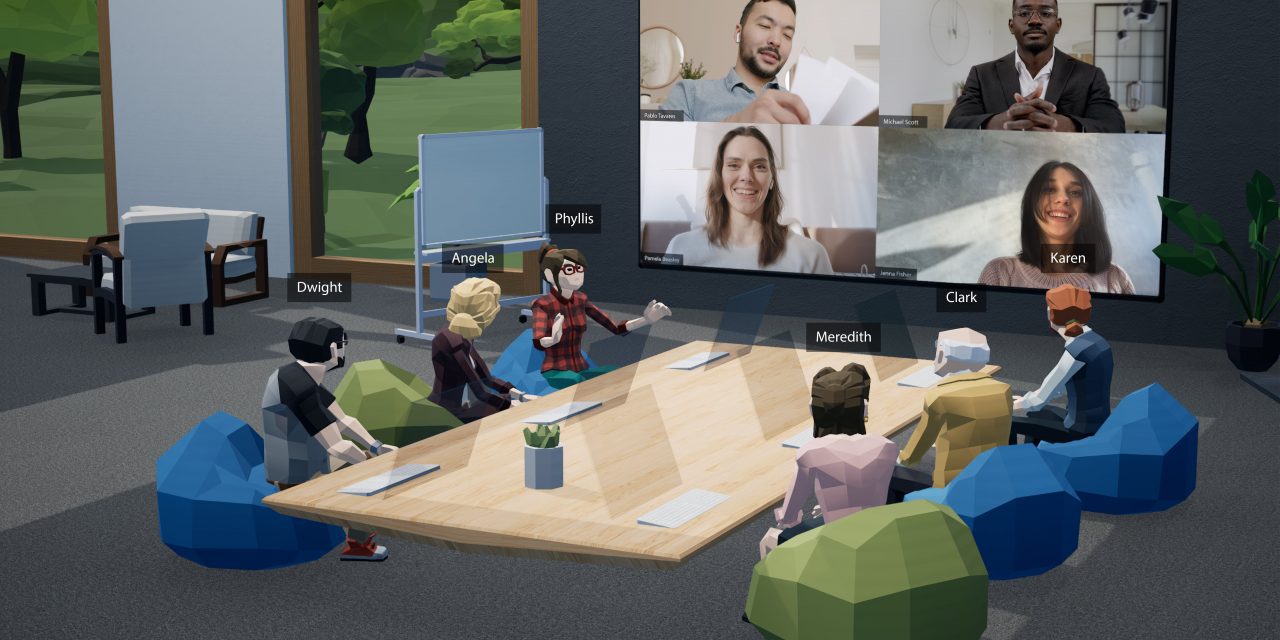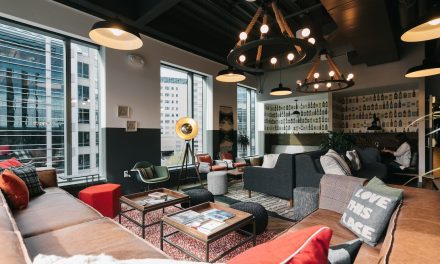Three years into the pandemic, a lot has changed. For many workers, the change came from how they work.
A recent survey of remote workers and freelancers showed that most (64%) of the workers believe that remote work is best suited for individual work. Furthermore, almost a third (32%) of the surveyed workers said they would quit their jobs if forced to return to their offices.
However, another study of remote workers and freelancers indicated that though most workers liked working remotely, the majority also enjoyed socialization in the office.
Despite the popularity of freelancing and remote work, socialization in the office is still necessary for many people. This dilemma is the leading factor in the current success of the flexible work industry. The metaverse has the potential to provide a way out of this situation by offering “real” virtual offices, however strange that may sound.
The Flexible Workplace Industry
For most modern workers, the most successful solution to the need for location independence and socialization is found in the flexible workplace industry. The term refers to businesses that provide a shared workspace for their employees, typically on a subscription basis. This type of arrangement has a number of advantages for both employers and employees.
First, flexible workplaces allow employees to set their own hours and work from anywhere they can find an internet connection. This is ideal for workers who need to balance their work life with other responsibilities, such as caring for family members or attending school.
Second, flexible workplaces offer a more social environment than traditional offices. This is because employees are often working side-by-side in shared workspaces, which encourages collaboration and networking.
Finally, flexible workplaces tend to be more cost-effective than traditional office space. This is because businesses only need to pay for the workspace when it is being used rather than for a larger, permanent space.
Before coworking spaces were a thing, the only places available for remote workers were coffee shops and personal offices.
Working in coffee shops allowed workers to socialize and feel connected to other people, but it didn’t offer the workers, especially freelancers, the possibility of a business address.
This is where the virtual office comes into play.
The Virtual Office
One problem for remote workers working in coffee shops and even in coworking spaces is their lack of access to a real street address, which they could use as their business address to send and receive postal mail.
Renting a private office would have been a solution, but it would have defeated the purpose of location independence since they would’ve had to go to the office to pick up their mail themselves.
An effective solution that solved this problem both for remote workers and even small businesses that run remotely was the appearance of the virtual office.
A virtual office refers to a business or professional service that provides an office-like space or services for individuals or companies working remotely. This can include a physical address for mailing and receiving packages, a receptionist to answer calls, and access to conference rooms and other office amenities.

So, it’s a service meant to make remote businesses and workers seem as if they had a real office with a real street address, except neither the company nor the remote workers ever go to work there. However, despite the term “virtual,” virtual offices are actually real, physical places occupied by real people, only not by the companies and remote workers paying for the service.
These types of businesses have been around for decades and pretty much own the term “virtual office,” but the metaverse could change that in the coming years, as you’ll learn further down this post.
Virtual offices are also ideal for small business owners and freelancers who want to build business credit since lenders still like to see a physical business address tied to the businesses they lend to. The same can be said for company CEOs looking to apply for their first business credit card since you wont find many instant approval credit cards for businesses.
The Coworking Space
The coworking space aims to solve a similar problem, but instead of just providing remote workers, freelancers, and companies with a business address, it also provides them with a space to work and in general it is easier to find a job. The setup is similar to renting a private office, but in a coworking space, the rent is split among many workers.
In a coworking space, the people that workers can socialize with are also workers, which makes them feel more connected. This situation is a big improvement from working in a coffee shop where the people you’re surrounded by are not necessarily working and thus be a barrier when socializing.
In essence, the coworking space is what you get when you combine the office and a coffee shop into a single room. It results in a highly collaborative space full of productive people. It has everything a remote worker needs; a place to work, peers to connect with, and amenities that help you be more productive and even have fun.
Self Expression and Workplace Personalization
While the virtual office and the coworking space have provided for the worker’s need for independence and socialization, it does not fulfill their need to express themselves through workplace personalization. According to a case study, workplace personalization makes people feel comfortable and enthusiastic about their work and thus become more productive.
When you own a space like a house or a private office, you’ll usually personalize the space and make it an expression of yourself. You’d put up some pictures that tell something about you, put some wall decor that you find appealing, or even paint its walls to reflect your favorite color. In a way, customizing personal space to express ourselves is a basic human instinct.
Unfortunately, the experience of personalizing and expressing yourself through your workspace is unavailable in a coworking or virtual office since it is a shared space. Designers tried to solve this problem in the past decades but ultimately failed and produced the dystopian version of an office, the cubicle farm.
The Traditional Office and The Cubicle Farm
The first office developers built was purely focused on space efficiency and the maximization of worker productivity. Thus, its design is just an open space with rows of desks for the workers.
Then, after some time, this open space evolved to accommodate a separate office for the C.E.O., a socialization space, and some support spaces like the office pantry. This evolution in office design, just like the coworking space, is done to satisfy the social needs of the workers.
However, designers encountered the same problem in traditional office design. Despite meeting the worker’s need for socialization, it does not allow its workers to personalize their work environment. So, to solve this problem, the office cubicle was invented. The idea was to give each worker their personal space through the office cubicle, which the worker could customize to their liking.
However, despite its noble intention, the office cubicles isolated the workers from each other and were criticized for being too depressing. This connotation earned this design the nickname “cubicle farms” because of its dehumanizing effect on its workers.
Today, though office cubicles are still in use, many people despise them because of the insufficient space and privacy they provide.
The Goldilock Zone – A.K.A. The Metaverse
Technology is bringing the perfect solution for this and several other new dilemmas through the metaverse. The metaverse is an emerging field of technology that companies market as a separate universe within the internet. Some even describe it as having another life in an online universe.
If you think this concept is right out of a dystopian sci-fi movie, you’re totally wrong. It came out of a dystopian sci-fi novel called Snowcrash! Jokes aside, while some fear what this new frontier could mean for society, others clearly see the potential benefits it can also offer.

One of these benefits is the possibility of meeting in virtual reality (V.R.) with anyone, anywhere in the world, in real-time, and just like if you were in the same place. In other words, it opens the door to virtual spaces where remote teams can get together to collaborate on different projects, even though they’re on opposite ends of the planet. It opens the door to the true virtual office.
Socialization in the Metaverse
Socializing through an avatar in an interconnected V.R. world is as close as a remote worker can get to a water bottle conversation with a coworker at the office. This is possible in the metaverse, not on your typical Monday Zoom meeting.
This shows that the metaverse has the potential to solve some of the critical issues with remote and flexible work arrangements and freelancing.
It’s also an even better way to network since you’re not limited by your geographical location. By combining the benefits of your local coworking space with immediate access to other coworkers from around the world, your networking can go through the roof in no time.
Client Relations in a Metaverse Virtual Office
Your private space is a reflection of who you are as a person. The same is true with your private office, one of the first things your client sees when you meet them. As I mentioned before, remote and hybrid workers who work from coworking spaces seldom have the opportunity to customize their space. However, in a virtual office in the metaverse, you’ll have complete freedom to make the space exactly what you want it to be.
Imagine what experiences you could create for your potential clients if you could customize your office in whatever way you want without the physical constraints of the real world!
In addition, you don’t need to spend money on renovations, no maintenance, no need for legal compliance, etc. That is what the metaverse offers.
With the metaverse, you can meet your client in an executive office on top of a skyscraper. Or you can meet them in an underwater office. If you can imagine it, you can make it happen; the sky is the limit.
Remote Teamwork in the Metaverse
Regarding teamwork and collaboration, traditional office and personal meetings are far superior to remote alternatives. We can attribute this superiority to the non-verbal communication that is hard to communicate effectively through a Zoom call or Google Meet meeting.
But what if we could enhance remote collaborative work through virtual or augmented reality and the metaverse?
Using these technologies could improve team communication to levels comparable to personal meetings and beyond. The integration of all sort of productivity tools into your virtual meeting environment would make everything faster and collaboration more effective.
Customer Service in the Metaverse
Have you ever worked in customer service and struggled to communicate with the customer because of inaccurate communication? Metaverse technology can help alleviate this situation by enhancing virtual and augmented reality communication.
Imagine a customer trying to describe to the technician what is wrong with their blender through the phone. It’s a perfect recipe for misunderstandings and miscommunication.
However, suppose the communication is done in the metaverse with a digital twin of the client’s blender. In that case, the customer can just show the technician what is wrong with their blender, and the technician can help the customer fix it, just as if they were there.
Financial Opportunities: Centralized vs. Decentralized Metaverse
The metaverse is still in its infancy, and we’re still very much in uncharted waters. It is full of potential not just for theoretical applications but also for its potential financial value.
Remember how Facebook became a billion-dollar company because of pioneering social media and connecting people? The same thing can happen with the metaverse.
This is exactly why Facebook rebranded to Meta Platforms earlier this year, and is investing millions into making the metaverse a reality.
Currently, there are two types of metaverses in development: centralized and decentralized metaverses. Each offers similar solutions to companies that want to monetize them but in different ways.
The Metaverse that Meta is developing is an example of a centralized Metaverse, which means it will be governed and maintained by a company, in this case, by Meta. In a centralized Metaverse, the market model will likely be similar to how most companies monetize social media through third-party ads.
On the other hand, decentralized metaverses are metaverses powered by blockchain technology that will be governed and secured by token holders. Individuals can monetize this type of metaverse through in-world NFT marketplaces, NFT sales, NFT royalties, and 3rd-party ads. Also, owners of its governance tokens can sell their tokens when their price goes up, similar to how real estate investors buy and sell properties.

In addition, the metaverse economy will also be based on cryptocurrencies, especially those native to the particular blockchain that runs the platform. This creates many opportunities for companies to adopt crypto as a form of payment and possibly offer crypto signup bonuses, crypto cash backs, and other rewards to loyal customers.
Either model offers the possibility of offering virtual offices where workers and clients from anywhere in the world can come together to meet, work, socialize, shop, and, in general, live out their virtual lives.
Final Thoughts
The metaverse can help build upon the improvement of the remote working experience by the flexible workplace industry. It offers the possibility for remote and hybrid workers, freelancers, and companies to set up true virtual offices.
In the near future, the virtual office will cease to be seen as a business address or related remote office services offered by one business. Instead, it will be recognized as what the term clearly implies: a virtual reality space that runs on the metaverse and that you can access through a V.R. headset from wherever you are.








